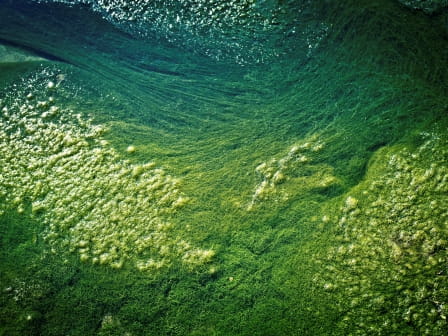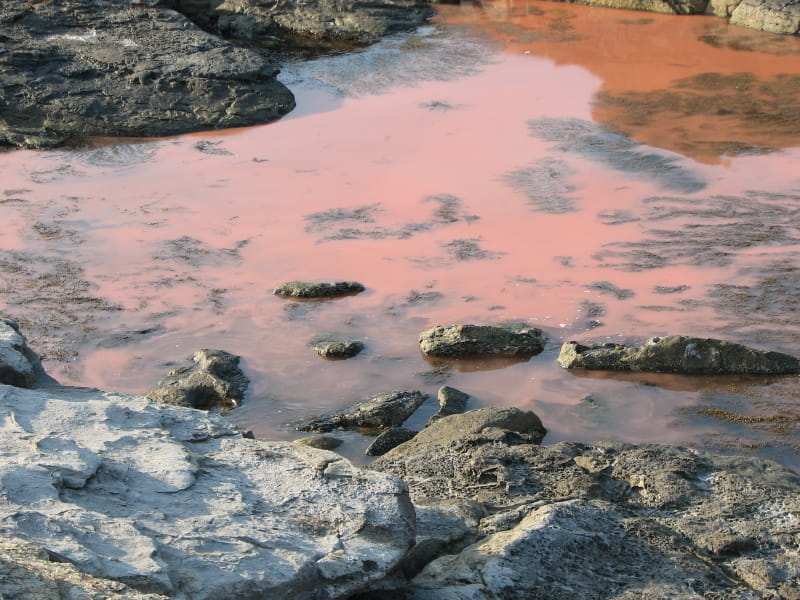Harmful Algal Blooms Warm Weather Worries

The Bottom Line
Warm temperatures, sunlight, and added nutrients can cause an overgrowth or “bloom” of algae in bodies of water. Some algae produce toxins that can poison people or animals when they swallow, swim in, or inhale the water or when they eat fish that live there.

The Full Story
You’ve probably heard about harmful algal blooms (HABs) or "red tides" in the news and in health advisories. This is especially true if you live in or have traveled to coastal areas of the US. In recent years, HABs have been raising public health and environmental concern worldwide.
So what are HABs? Why are they harmful, and what causes them?
Algae are simple, nonflowering plants that live in water. They range in size from microscopic to large plants like seaweed. Algae are essential for the health of ocean and fresh-water ecosystems. The majority of algae are harmless. HABs are caused by microscopic kinds of algae.
Sometimes, there can be an overgrowth (bloom) of algae. This occurs when there are changes in the water that result in increased amounts of nutrients that algae need, such as nitrogen and phosphorus. Human activity seems to be causing HABs to occur more often and to be more severe. For example, fertilizer can run off from farm fields into nearby water. When the algae receive these rich nutrients, they grow very quickly. Even though they are microscopic, the huge number of algae can turn the water to shades of red, brown, yellow, or green. The color depends on the type of algal species in bloom. This is where the term “red tide” comes from. There can also be scum or film on the surface of the water.
Algal blooms usually occur in the summer and early fall. They threaten the health of the environment, plants, animals, and people. They use up oxygen and block sunlight that other marine organisms need to survive. Some of them also produce toxins that can harm or even kill fish, other marine animals, and people. The toxins that some algae produce accumulate in shellfish like scallops, clams, mussels, and oysters. People become ill when they eat these contaminated shellfish.
In the US, and especially in the Gulf of Mexico and in the Southeastern and Mid-Atlantic coasts, neurotoxic shellfish poisoning (NSP) is one of the illnesses that can result. Neurotoxic shellfish poisoning is characterized by numbness and tingling of the face, hands, and feet as well as nausea, vomiting, and diarrhea. Generally, the symptoms go away without treatment after about 3 days. Very few neurotoxic shellfish poisoning cases occur in the US because many shellfish beds are monitored closely for HABs.
Another illness that can result from HABs is ciguatera fish poisoning. Similar to neurotoxic shellfish poisoning, ciguatera occurs when people eat fish that have been exposed to toxins from algae (a different kind of algae than the one that causes neurotoxic shellfish poisoning). The ciguatera toxin is produced by algae that usually grow near Caribbean and Pacific Islands. However, poisoning can occur anywhere the contaminated fish are eaten. People with ciguatera fish poisoning can have the same kinds of symptoms as those with neurotoxic shellfish poisoning, but a common and unique feature of ciguatera is sensory reversal in which cold things feel hot and hot things feel cold. Most people with ciguatera fish poisoning recover without treatment, but symptoms can last for weeks. The toxin increases in concentration as it moves up the food chain and is highest in large fish that have eaten smaller fish that have eaten the toxic algae. Therefore, people usually become poisoned after consuming large fish like barracuda, king mackerel, and hogfish.
Swimming in water with HABs can cause skin irritation, rash, and itching as well as nose, eye, and throat irritation. People with asthma might develop more asthma symptoms, especially if they inhale airborne droplets. Swallowing the water can cause nausea, vomiting, diarrhea, and abdominal pain.
There are specific steps that you can take to prevent poisoning from HABs:
- Avoid contact with water that is discolored or has scum or film floating on its surface.
- Avoid recreational activities, like playing, swimming or boating, in such water.
- Do not fish at lakes that are discolored or where algal scum is present.
- Never drink untreated water from lakes, streams, or rivers.
- Do not let pets drink from or swim in such water.
If you are exposed to water that might be contaminated by a HAB, immediately wash with soap and water. Call Poison Control at 1-800-222-1222 for advice if you are having health problems you think are related to a HAB. If you suspect a HAB on a public lake or seashore, report it to the local health department.
Serkalem Mekonnen, RN, BSN, MPH
Certified Specialist in Poison Information
Prevention Tips
- Avoid contact with water that is discolored or has scum or film floating on its surface.
- Avoid recreational activities, like as playing, swimming or boating, in such water.
- Do not fish at lakes that are discolored or where algal scum is present.
- Never drink untreated water from lakes, streams, or rivers.
- Do not let pets drink from or swim in such water.
This Really Happened
A 36-year-old man went to an emergency room (ER) 6 hours after returning from Aruba. He had nausea, several episodes of vomiting and diarrhea, sweating, and abdominal pain. The symptoms began about 3 hours after returning home from his vacation. He told the ER staff that he might have eaten “bad” fish just prior to departing from Aruba.
In the ER, he was treated with intravenous fluids. He felt better, did not have any further symptoms, and was discharged.
He returned to the ER 6 hours later. This time, he had called 911 and was brought in by ambulance. The gastrointestinal symptoms had recurred, and new symptoms developed: itchiness, numbness around the mouth, and muscle pain. He also reported sensory reversal (cold felt hot and hot felt cold).
He was admitted to the hospital, and diagnosed with ciguatera fish poisoning based on his history and the nature of his symptoms. He was treated with antihistamines and intravenous fluids and went home 2 days later.
Reference: Asaeda G. The transport of ciguatoxin: a case report. J Emerg Med. 2001;20:263-5.
For More Information
Ciguatera Fish Poisoning, from The Poison Post®
References
Asaeda G. The transport of ciguatoxin: a case report. J Emerg Med. 2001;20:263-5.
Watkins SM, Reich A, Fleming LE, Hammond R. Neurotoxic shellfish poisoning. Mar Drugs. 2008;6:431-5.
Prevention Tips
- Avoid contact with water that is discolored or has scum or film floating on its surface.
- Avoid recreational activities, like as playing, swimming or boating, in such water.
- Do not fish at lakes that are discolored or where algal scum is present.
- Never drink untreated water from lakes, streams, or rivers.
- Do not let pets drink from or swim in such water.
This Really Happened
A 36-year-old man went to an emergency room (ER) 6 hours after returning from Aruba. He had nausea, several episodes of vomiting and diarrhea, sweating, and abdominal pain. The symptoms began about 3 hours after returning home from his vacation. He told the ER staff that he might have eaten “bad” fish just prior to departing from Aruba.
In the ER, he was treated with intravenous fluids. He felt better, did not have any further symptoms, and was discharged.
He returned to the ER 6 hours later. This time, he had called 911 and was brought in by ambulance. The gastrointestinal symptoms had recurred, and new symptoms developed: itchiness, numbness around the mouth, and muscle pain. He also reported sensory reversal (cold felt hot and hot felt cold).
He was admitted to the hospital, and diagnosed with ciguatera fish poisoning based on his history and the nature of his symptoms. He was treated with antihistamines and intravenous fluids and went home 2 days later.
Reference: Asaeda G. The transport of ciguatoxin: a case report. J Emerg Med. 2001;20:263-5.
